Paper Menu >>
Journal Menu >>
 Applied Mathematics, 2010, 1, 265-273 doi:10.4236/am.2010.14033 Published Online October 2010 (http://www.SciRP.org/journal/am) Copyright © 2010 SciRes. AM A Characterization of Semilinear Surjective Operators and Applications to Control Problems* Edgar Iturriaga, Hugo Leiva Grupo de Matemática Aplicada, Departamento de Matemáticas, Universidad de Los Andes, Mérida, Venezuela E-mail: iturri@ula.ve and hleiva@ula.ve Received April 28, 2010; revised July 30, 2010; accepted August 3, 2010 Abstract In this paper we characterize a broad class of semilinear surjective operators H GV Z given by the fol- lowing formula () H Gw Gw Hw ,wV where ,V Z are Hilbert spaces, ()GLVZ and HV Z is a suitable nonlinear function. First, we give a necessary and sufficient condition for the linear operator G to be surjective. Second, we prove the following statement: If () R ang GZ and H is a Lipschitz func- tion with a Lipschitz constant h small enough, then () H R ang GZ and for all zZ the equation () GwH wz admits the following solution 111 ()( ()) z wGGG IHGGGz .We use these results to prove the exact controllability of the following semilinear evolution equation () (())zAzButFtzut , 0zZuUt, where Z , U are Hilbert spaces, ()ADA ZZ is the infinitesimal generator of strongly continuous semigroup 0 {()} t Tt in Z B (),LU Z the control function u belong to 2(0 )LU and [0] F ZU Z is a suitable function. As a particular case we consider the semilinear damped wave equation, the model of vibrating plate equation, the integrodifferential wave equation with Delay, etc. Keywords: Semilinear Surjective Operators, Evolution Equations, Controllability, Damped Wave Equation 1. Introduction In this paper we characterize a broad class of semilinear surjective operators H GV Z given by the following formula () H GwGwHwwV (1.1) Where Z , V are Hilbert spaces, GV Z is a bounded linear operator (continuous and linear) and H VZ is a suitable non linear function in general nonlinear. First, we give a necessary and sufficient con- dition for the linear operator G to be surj ective. Secon d, we prove the following statement: If ()Rang GZ and H is a Lipschitz function with a Lipschitz constant h small enough, then () H Rang GZ and for all zZ the equation ()GwH wz admits the following solution 111 ()(()) z wGGG IHGGGz We apply our results to prove the exact controllability of the following semilinear evolution equation () (())0zAzButFtzutzZuUt (1.2) where Z and U are Hilbert spaces, () A DA ZZ is the infinitesimal generator of strongly continuous se- migroup 0 {()} t Tt in () Z BLUZ , the control func- tion u belong to 2(0 )LU and [0] F ZUZ is a suitable function. We give a necessary and sufficien t condition for the exact controllability of the linear sys- tem () 0zAzButzZuUt (1.3) Under some conditions on F, we prove that the control- lability of the linear system (1.3) is preserved by the semi- linear system (1.2). In this case the control 2(0 )uL U steering an initial state 0 z to a final state 1 z at time 0 (using the non linear system (1.2)) is given by the following formula: 11 10 ()()()(( ))utBTtIKzTz W where K ZZ is non linear operator gi ven by: 0()(()()()) K TsFszsSsds and ()z is the solution of (1.2) corresponding to the *This work was supported by the CDCHTA-PROJECT: C-1667-09- 05-AA 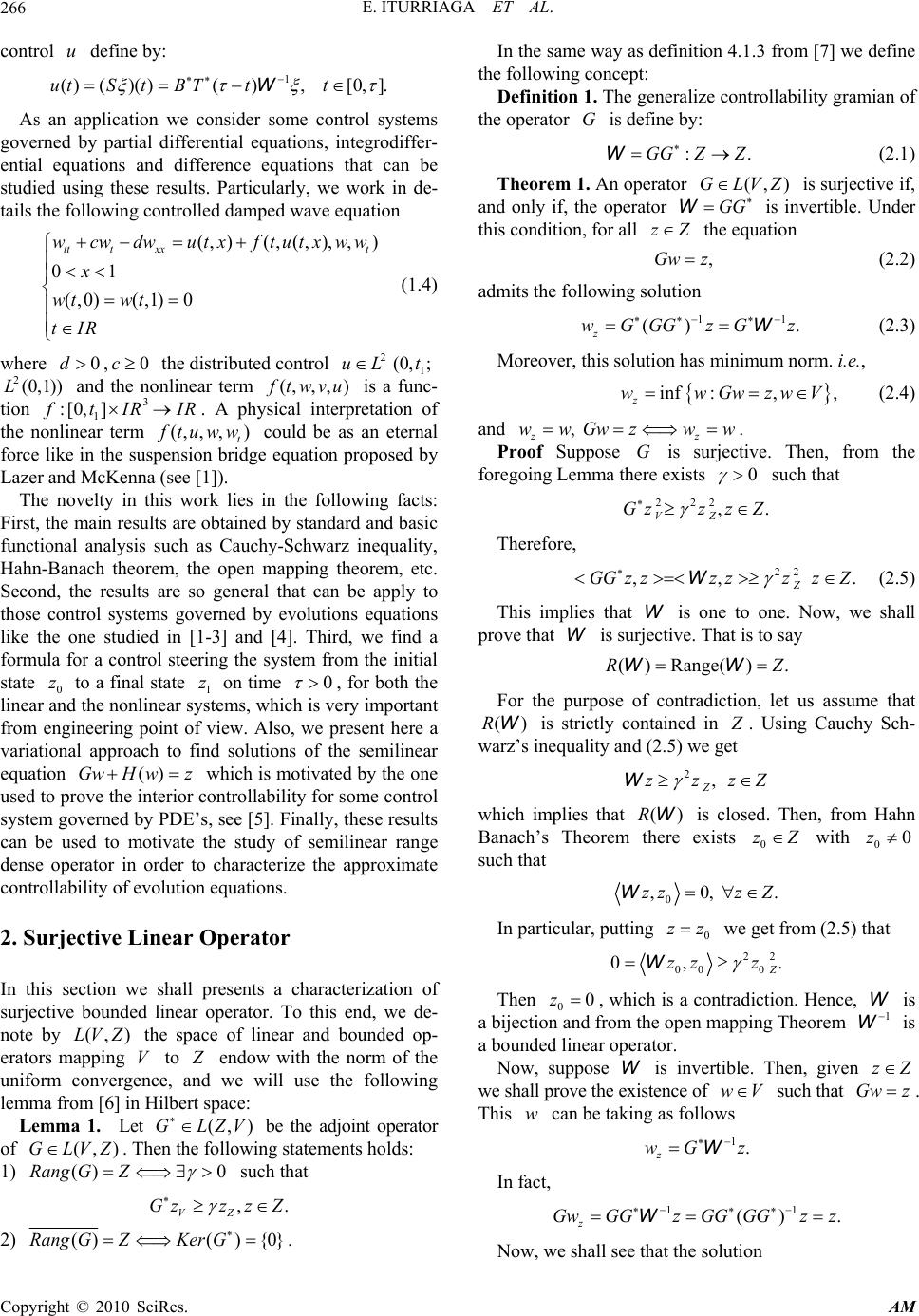 E. ITURRIAGA ET AL. Copyright © 2010 SciRes. AM 266 control u define by: 1 ()()()()[0 ]utS tBTtt W As an application we consider some control systems governed by partial differential equations, integrodiffer- ential equations and difference equations that can be studied using these results. Particularly, we work in de- tails the following controlled damped wave equation () (()) 01 (0)(1) 0 tt txxt wcwdwutxftutxww x wt wt tIR (1.4) where 0d,0c the distributed control 2 uL1 (0 t 2(0 1))L and the nonlinear term () f twvu is a func- tion 3 1 [0 ] f tIR IR . A physical interpretation of the nonlinear term () t f tuww could be as an eternal force like in the suspension bridge equation proposed by Lazer and McKenna (see [1]). The novelty in this work lies in the following facts: First, the main results are obtained by standard and basic functional analysis such as Cauchy-Schwarz inequality, Hahn-Banach theorem, the open mapping theorem, etc. Second, the results are so general that can be apply to those control systems governed by evolutions equations like the one studied in [1-3] and [4]. Third, we find a formula for a control steering the system from the initial state 0 z to a final state 1 z on time 0 , for both the linear and the nonlinear systems, which is very important from engineering point of view. Also, we present here a variational approach to find solutions of the semilinear equation ()GwH wz which is motivated by the one used to prove the interior controllability for some control system governed by PDE’s, see [5]. Finally, these results can be used to motivate the study of semilinear range dense operator in order to characterize the approximate controllability of evolution equations. 2. Surjective Linear Operator In this section we shall presents a characterization of surjective bounded linear operator. To this end, we de- note by ()LV Z the space of linear and bounded op- erators mapping V to Z endow with the norm of the uniform convergence, and we will use the following lemma from [6] in Hilbert space: Lemma 1. Let ()GLZV be the adjoint operator of ()GLVZ. Then the following statements holds: 1) () 0Rang GZ such that VZ Gzz zZ 2) ()(){0}Rang GZKer G . In the same way as definition 4.1.3 from [7] we define the following concept: Definition 1. The generalize controllability gramian of the operator G is define by: GG ZZ W (2.1) Theorem 1. An operator ()GLVZ is surjective if, and only if, the operator GG W is invertible. Under this condition, for all zZ the equation Gw z (2.2) admits the following solution 11 () z wGGG zGz W (2.3) Moreover, this solution has minimum norm. i.e., inf z wwGwzwV (2.4) and zz wwGwz ww . Proof Suppose G is surjective. Then, from the foregoing Lemma there exists 0 such that 222 VZ Gzz z Z Therefore, 22 Z GGzzzzzz Z W (2.5) This implies that W is one to one. Now, we shall prove that W is surjective. That is to say ()Range()RZ WW For the purpose of contradiction, let us assume that ()RW is strictly contained in Z . Using Cauchy Sch- warz’s inequality and (2.5) we get 2, Z zzzZ W which implies that ()RW is closed. Then, from Hahn Banach’s Theorem there exists 0 zZ with 00z such that 00, .zzz Z W In particular, putting 0 zz we get from (2.5) that 22 00 0 0 Z zz z W Then 00z , which is a contradiction. Hence, W is a bijection and from the open mapping Theorem 1 W is a bounded linear operator. Now, suppose W is invertible. Then, given zZ we shall prove the existence of wV such that Gw z . This w can be taking as follows 1 z wG z W In fact, 11 () z GwGGzGG GGzz W Now, we shall see that the solution  E. ITURRIAGA ET AL. Copyright © 2010 SciRes. AM 267 11 () z wGGG zGz W of the Equation (2.2) has minimum norm. In fact, let wV such that Gw z and consider 222 2 () 2Re zzz z zz wwww w www ww On the other hand, 1 11 0 zz z z www G zww zGw Gwzzz W WW Hence, 22 2 0 zz ww ww. Therefore, z ww, a nd z ww if z ww. Corollary 1. If an operator ()GLVZ is surjective, then the operator SZ V defined by: 1 SG W (2.6) is a right inverse of G. i.e., GSI. Definition 2. Under the condition of the above theo- rem the operator 1 SGZ V W is called the generalize steering operator. Lemma 2. An operator ()GLVZ satisfies ()Rang GZ if, and only if, ()Rang ZW. Proof Suppose that ()Rang GZ. Then, from Lemma 1 part(2) we have that 00zzz ZzW (2.7) For the purpose of contradiction, let us assume that ()Rang ZW Then, from Hanh Banach’s Theorem there exists 00z such that 00 .zzz ZW In particular, if we put 0 zz , then 00 0zz W, which contradicts (2.7). Now, suppose that ()Rang ZW. Then, ()Rang GGZ , and consequently ()Rang GZ. 2.1. Variational Method to Obtain Solutions The Theorem 1 gave a formula for one solution of the system (2.2) which has minimum norma. But, it is not the only way allowing to build solutions of this equation. Next, we shall present a variational method to obtain solutions of (2.2) as a minimum of the quadratic functional Z IR, 2 1 () 2Gz Z (2.8) Proposition 1. For a given zZ the Equation (2.2) has a solution wV if, and only if, 0wGzZ (2.9) It is easy to see that (2.9) is in fact an optimality con- dition for the critical points of the quadratic functional define above. Lemma 3. Suppose the quadratic functional has a minimizer z Z . Then, z z wG (2.10) is a solution of (2.2). Proof. First, observe that has the following form 1 () 2GG zZ Then, if z is a point where achieves its minimum value, we obtain that {}( )0 zz dGG z d So, z GG z and z z wG is a solution of (2.2). Remark 1. Under the condition of Theorem 1, the solution given by the formulas (2.10) and ( 2.3) coincide. Theorem 2. The system (2.2) is solvable if, and only if, the quadratic functional defined by (2.8) has a mini- mum for all zZ . Proof Suppose (2.2) is solvable. Then, the operator G is surjective. Hence, from Lemma 1 there exists 0 such that 222 GZ Then, 22 () 2zZ Therefore, lim( ) Consequently, is coercive and the existence of a minimum is ensured. The other way of the proof follows as in proposition 1. 3. Surjective Semlinear Operators In this section we shall look for conditions under which the semilinear operator H GV Z given by: (), , H GwGwHww V (3.1) is surjective. To this end, we shall use the following theo- rem from non linear analysis. 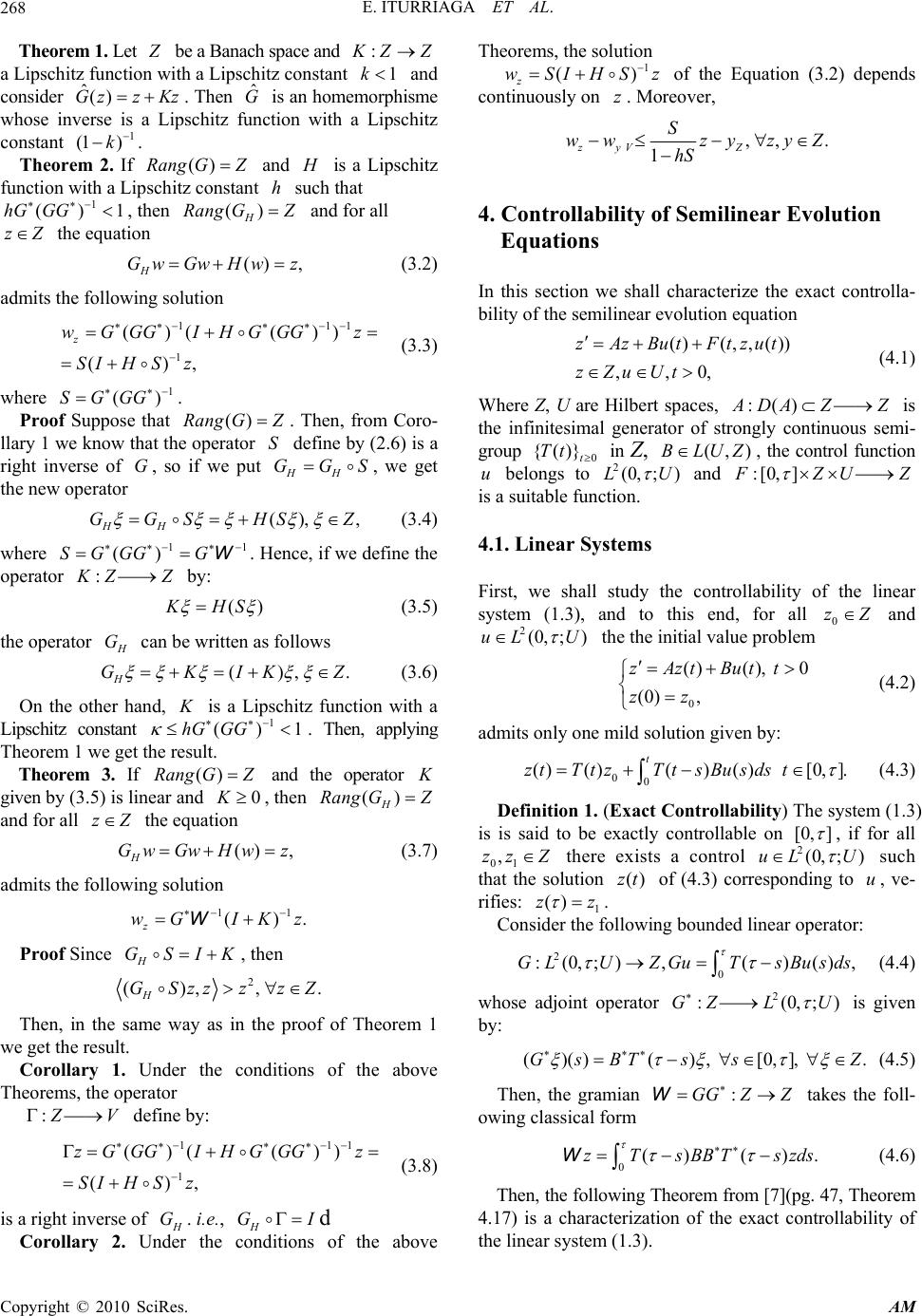 E. ITURRIAGA ET AL. Copyright © 2010 SciRes. AM 268 Theorem 1. Let Z be a Banach space and K ZZ a Lipschitz function with a Lipschitz con s tant 1k and consider ˆ() GzzKz . Then ˆ G is an homemorphisme whose inverse is a Lipschitz function with a Lipschitz constant 1 (1 )k . Theorem 2. If ()Rang GZ and H is a Lipschitz function with a Lipschitz constant h such that 1 ()1hG GG , then () H Rang GZ and for all zZ the equation () H GwGw Hwz (3.2) admits the following solution 111 1 ()( ()) () z wGGG IHGGGz SIHSz (3.3) where 1 ()SGGG . Proof Suppose that ()Rang GZ. Then, from Coro- llary 1 we know that the operator S define by (2.6) is a right inverse of G, so if we put HH GGS, we get the new operator () HH GGSHS Z (3.4) where 11 ()SGGG G W. Hence, if we define the operator K ZZ by: () K HS (3.5) the operator H G can be written as follows () H GKIKZ (3.6) On the other hand, K is a Lipschitz function with a Lipschitz constant 1 ()1hG GG . Then, applying Theorem 1 we get the result. Theorem 3. If ()Rang GZ and the operator K given by (3. 5) i s linear an d 0K, then () H Rang GZ and for all zZ the equation () H GwGw Hwz (3.7) admits the following solution 11 () z wG IKz W Proof Since H GSIK, then 2 () H GSzzz zZ Then, in the same way as in the proof of Theorem 1 we get the result. Corollary 1. Under the conditions of the above Theorems, the operator Z V define by: 111 1 ()( ()) () zGGG IHGGGz SIHSz (3.8) is a right inverse of H G. i.e., H GId Corollary 2. Under the conditions of the above Theorems, the solution 1 () z wSIHSz of the Equation (3.2) depends continuously on z. Moreover, 1 zyV Z S wwzy zyZ hS 4. Controllability of Semilinear Evolution Equations In this section we shall characterize the exact controlla- bility of the semilinear evolution equation () (()) 0 zAzButFtzut zZuUt (4.1) Where Z, U are Hilbert spaces, () A DA ZZ is the infinitesimal generator of strongly continuous semi- group 0 {()} t Tt in Z, ()BLUZ , the control function u belongs to 2(0 )LU and [0 ] F ZUZ is a suitable function. 4.1. Linear Systems First, we shall study the controllability of the linear system (1.3), and to this end, for all 0 zZ and 2(0 )uL U the the initial value problem 0 ()() 0 (0) zAztButt zz (4.2) admits only one mild solution given by: 00 ()()()() [0] t ztTtzTtsBusds t (4.3) Definition 1. (Exact Controllability) The system (1.3) is is said to be exactly controllable on [0] , if for all 01 zzZ there exists a control 2(0 )uLU such that the solution ()zt of (4.3) corresponding to u, ve- rifies: 1 ()zz . Consider the following bounded linear operator: 2 0 (0)()( )GLUZGuT sBusds (4.4) whose adjoint operator 2(0 )GZL U is given by: ()()() [0] GsBT ssZ (4.5) Then, the gramian GG ZZ W takes the foll- owing classical form 0() ()zTsBBTszds W (4.6) Then, the following Theorem from [7](pg. 47, Theorem 4.17) is a characterization of the exact controllability of the linear system (1.3). 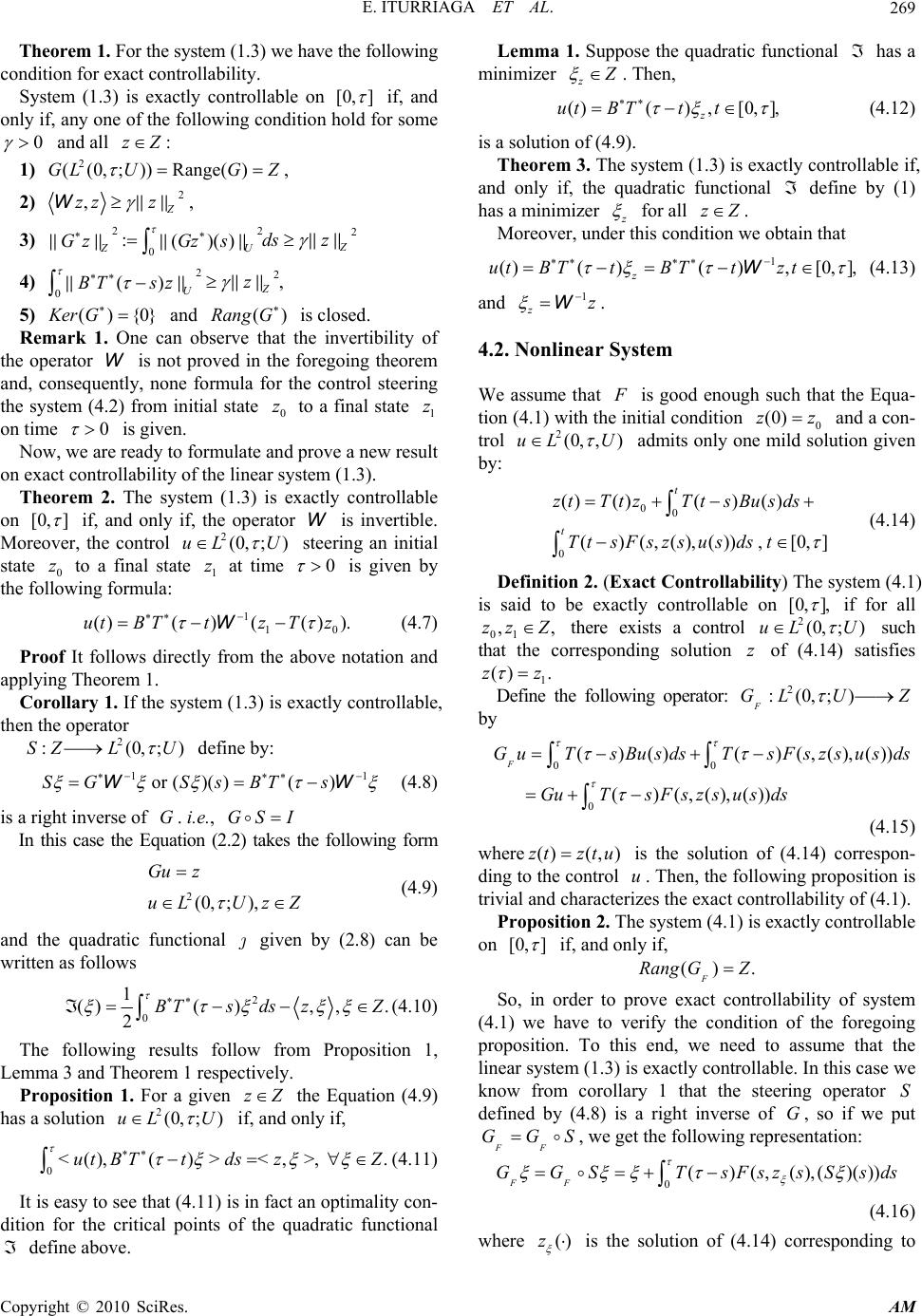 E. ITURRIAGA ET AL. Copyright © 2010 SciRes. AM 269 Theorem 1. For the system (1.3) we have the following condition for exact controllability. System (1.3) is exactly controllable on [0] if, and only if, any one of the following condition hold for some 0 and all zZ 1) 2 ((0))Range( )GLUG Z , 2) 2 Z zz z W, 3) 22 2 0()() Z UZ ds z Gz s Gz 4) 22 0() Z Uz BT sz 5) (){0}Ker G and ()Rang G is closed. Remark 1. One can observe that the invertibility of the operator W is not proved in the foregoing theorem and, consequently, none formula for the control steering the system (4.2) from initial state 0 z to a final state 1 z on time 0 is given. Now, we are ready to formulate and prove a new result on exact controllability of the linear system (1.3). Theorem 2. The system (1.3) is exactly controllable on [0 ] if, and only if, the operator W is invertible. Moreover, the control 2(0 )uL U steering an initial state 0 z to a final state 1 z at time 0 is given by the following formula: 110 ()()(( ))utBTtz Tz W (4.7) Proof It follows directly from the above notation and applying Theorem 1. Corolla ry 1. If the system (1.3) is exactly controllable, then the operator 2(0 )SZL U define by: 11 or ()()()SGSsBT s WW (4.8) is a right inverse of G. i.e., GSI In this case the Equation (2.2) takes the following form 2(0 ), Gu z uL UzZ (4.9) and the quadratic functional given by (2.8) can be written as follows 2 0 1 ()( ) 2BTs ds zZ (4.10) The following results follow from Proposition 1, Lemma 3 and Theorem 1 respectively. Proposition 1. For a given zZ the Equation (4.9) has a solution 2(0 )uL U if, and only if, 0()() <u tBTt>ds<z>Z (4.11) It is easy to see that (4.11) is in fact an optimality con- dition for the critical points of the quadratic functional define above. Lemma 1. Suppose the quadratic functional has a minimizer z Z . Then, ()()[0] z ut BTtt (4.12) is a solution of (4.9). Theorem 3. The system (1.3) is exactly controllable if, and only if, the quadratic functional define by (1) has a minimizer z for all zZ. Moreover, under this condition we obtain that 1 () ()()[0] z ut BTtBTtzt W (4.13) and 1 zz W. 4.2. Nonlinear System We assume that F is good enough such that the Equa- tion (4.1) with the initial condition 0 (0)zz and a con- trol 2(0 )uL U admits only one mild solution given by: 00 0 ()()()() ()(()()),[0] t t ztTtzTt sBusds Tt sFszsusdst (4.14) Definition 2. (Exact Controllability) The system (4.1) is said to be exactly controllable on [0 ] if for all 01 zzZ there exists a control 2(0 )uL U such that the corresponding solution z of (4.14) satisfies 1 ()zz Define the following operator: 2(0 ) F GL UZ by 00 0 ()() ()(()()) ()(()()) F GuT sBusdsTsFszsusds GuTs F s z su sds (4.15) where ()()ztztu is the solution of (4.14) correspon- ding to th e contr ol u. Then, the following proposition is trivial and characterizes the exact controllability of (4.1). Proposition 2. The system (4.1) is exactly controllable on [0 ] if, and only if, () F Rang GZ So, in order to prove exact controllability of system (4.1) we have to verify the condition of the foregoing proposition. To this end, we need to assume that the linear system (1.3) is exactly controllable. In this case we know from corollary 1 that the steering operator S defined by (4.8) is a right inverse of G, so if we put FF GGS, we get the following representation: 0()(() ()()) FF GGSTsFszsSs ds (4.16) where ()z is the solution of (4.14) corresponding to 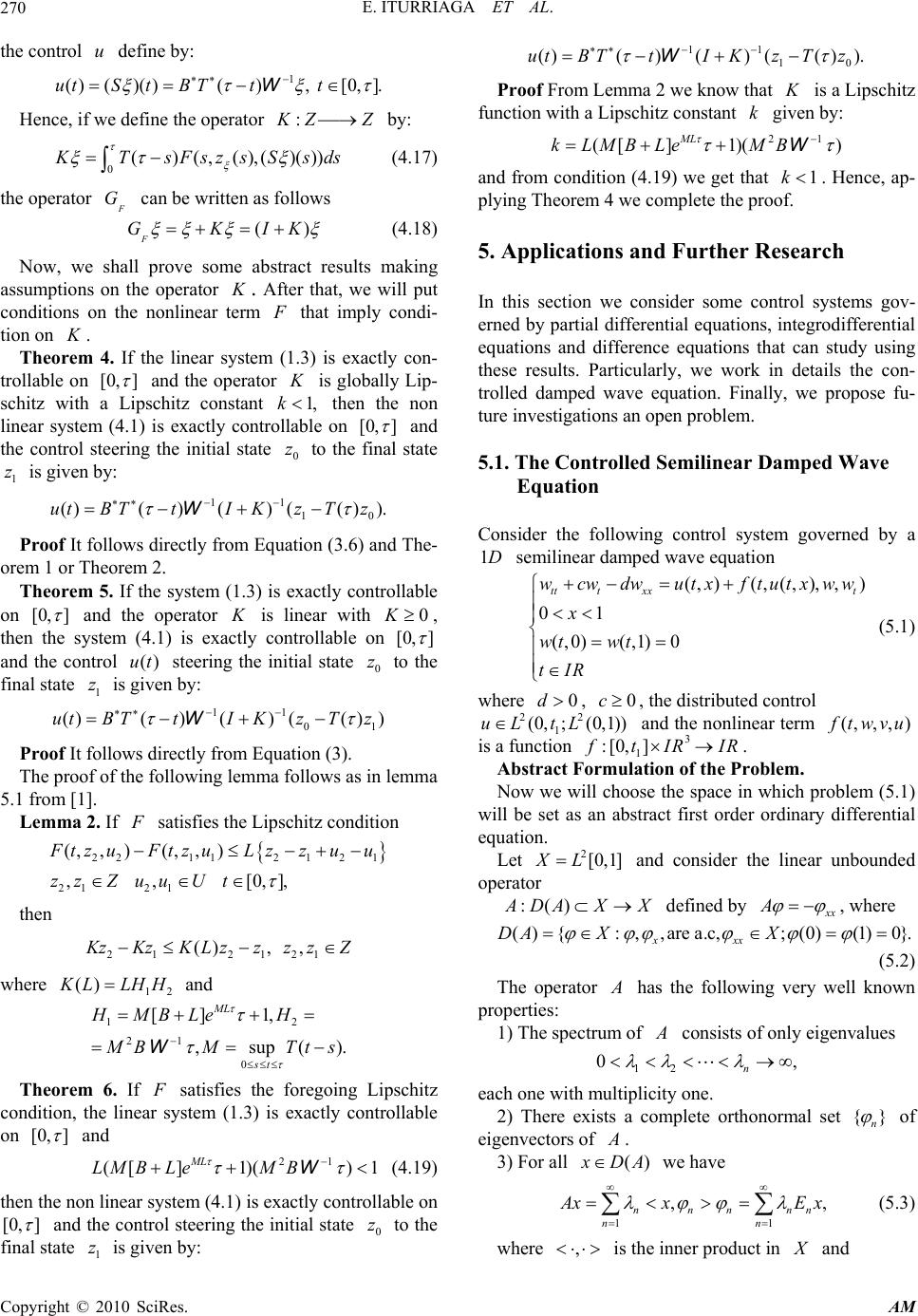 E. ITURRIAGA ET AL. Copyright © 2010 SciRes. AM 270 the control u define by: 1 ()()()() [0]utS tBTtt W Hence, if we define the operator K ZZ by: 0()(()()()) K TsFszsSsds (4.17) the operator F G can be written as follows () F GKIK (4.18) Now, we shall prove some abstract results making assumptions on the operator K . After that, we will put conditions on the nonlinear term F that imply condi- tion on K . Theorem 4. If the linear system (1.3) is exactly con- trollable on [0] and the operator K is globally Lip- schitz with a Lipschitz constant 1k then the non linear system (4.1) is exactly controllable on [0 ] and the control steering the initial state 0 z to the final state 1 z is given by: 11 10 ()()() (())utBTtI KzTz W Proof It follows directly from Equation (3.6) and Th e- orem 1 or The or em 2. Theorem 5. If the system (1.3) is exactly controllable on [0 ] and the operator K is linear with 0K, then the system (4.1) is exactly controllable on [0 ] and the control ()ut steering the initial state 0 z to the final state 1 z is given by: 11 01 ()()() (())utBTtI KzTz W Proof It follows directly from Equation (3). The proof of the following lemma follows as in lemma 5.1 from [1]. Lemma 2. If F satisfies the Lipschitz condition 22112 12 1 21 21 ()() [0] F tzuFtzuLzzuu zzZuuUt then 21 2121 () K zKzKLzzzzZ where 12 () K LLHH and 12 21 0 []1 sup () ML st HMBLe H M BM Tts W Theorem 6. If F satisfies the foregoing Lipschitz condition, the linear system (1.3) is exactly controllable on [0 ] and 21 ([ ]1)()1 ML LMBLeM B W (4.19) then the non linear system (4.1) is exactly controllable on [0 ] and the control steering the initial state 0 z to the final state 1 z is given by: 11 10 ()()()(( ))utBTtI KzTz W Proof From Lemma 2 we know that K is a Lipschitz function with a Lipschitz constant k given by: 21 ([ ]1)() ML kLMBLe MB W and from condition (4.19) we get that 1k. Hence, ap- plying Theorem 4 we complete the proof. 5. Applications and Further Research In this section we consider some control systems gov- erned by partial differential equations, integrodifferential equations and difference equations that can study using these results. Particularly, we work in details the con- trolled damped wave equation. Finally, we propose fu- ture investigations an open problem. 5.1. The Controlled Semilinear Damped Wave Equation Consider the following control system governed by a 1D semilinear damped wave equation () (()) 01 (0)(1)0 tt txxt wcwdw utxftutxww x wt wt tIR (5.1) where 0d, 0c, the distributed control 22 1 (0(0 1))uLtL and the nonlinear term ()ftwvu is a function 3 1 [0 ] f tIR IR . Abstract Formulation of the Problem. Now we will choose the space in which problem (5.1) will be set as an abstract first order ordinary differential equation. Let 2[0 1]XL and consider the linear unbounded operator () A DA XX defined by x x A , where () {areac,(0)(1)0} xxx DA XX (5.2) The operator A has the following very well known properties: 1) The spectrum of A consists of only eigenvalues 12 0n each one with multiplicity one. 2) There exists a complete orthonormal set {} n of eigenvectors of A . 3) For all () x DA we have 11 nnn nn nn A xx Ex (5.3) where is the inner product in X and 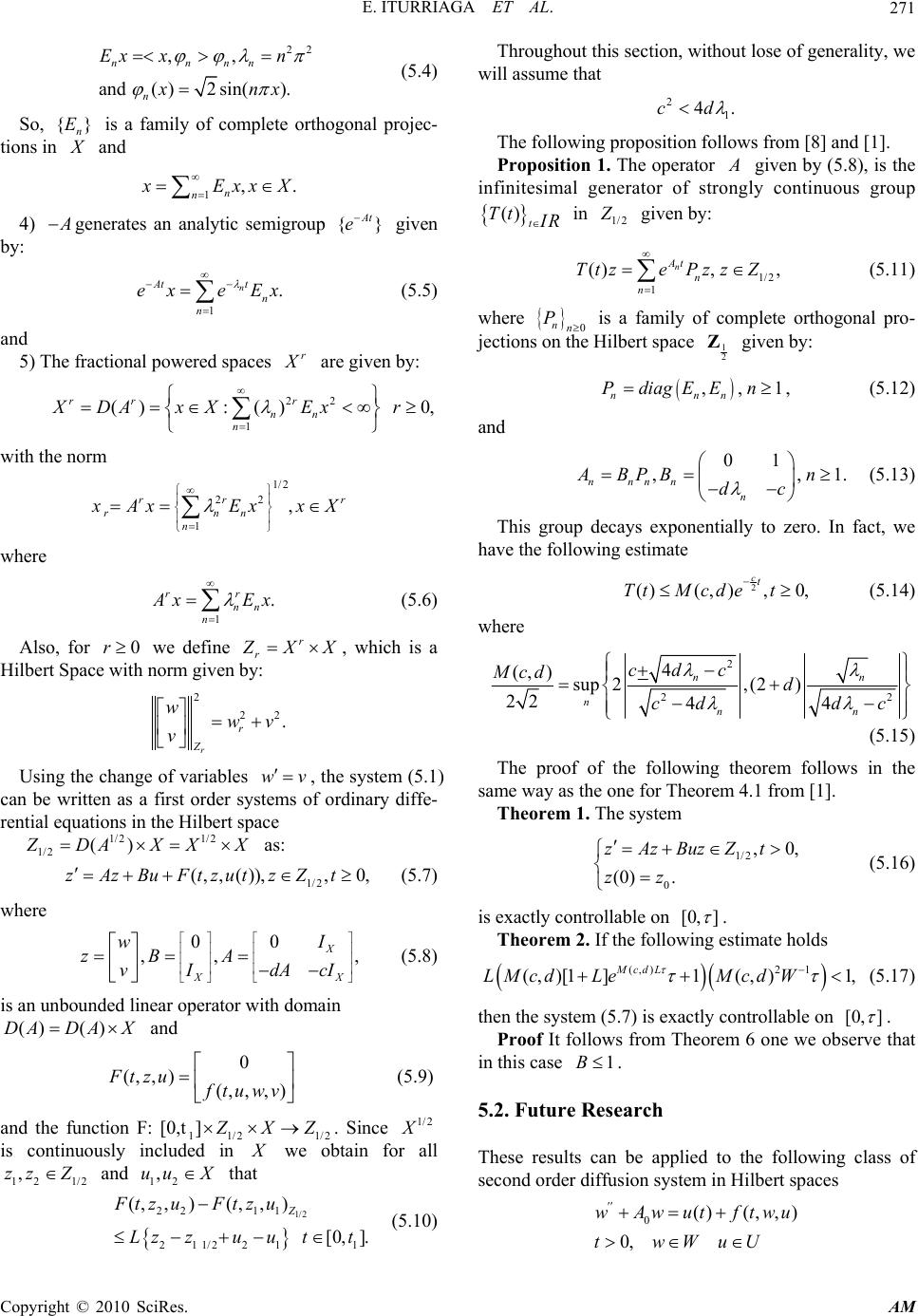 E. ITURRIAGA ET AL. Copyright © 2010 SciRes. AM 271 22 and ()2sin() nnnn n Ex xn xnx (5.4) So, {} n E is a family of complete orthogonal projec- tions in X and 1n n x Exx X 4) A generates an analytic semigroup {} At e given by: 1 nt At n n ex eEx (5.5) and 5) The fractional powered spaces r X are given by: 22 1 ()() 0 rr r nn n XDA xXExr with the norm 12 22 1 rr r rnn n x AxExx X where 1 rr nn n A xEx (5.6) Also, for 0r we define r r Z XX, which is a Hilbert Space with norm give n by : 2 22 r r Z wwv v Using the change of variables wv , the system (5.1) can be written as a first order systems of ordinary diffe- rential equations in the Hilbert space 12 12 12 () Z DAX XX as: 12 (())0zAzBuFtzutzZt (5.7) where 00 X XX I w zBA I dA cI v (5.8) is an unbounded linear operator with domain () ()DADA X and 0 ()() Ft zu f tu wv (59) and the function F: [0,t112 12 ] Z XZ . Since 12 X is continuously included in X we obtain for all 12 12 zz Z and 12 uu X that 12 22 11 211221 1 ()() [0] Z FtzuFtz u Lzzu utt (5.10) Throughout this section, without lose of generality, we will assume that 21 4cd The following proposition follows from [8] and [1]. Proposition 1. The operator A given by (5.8), is the infinitesimal generator of strongly continuous group ()t Tt I R in 12 Z given by: 12 1 () n At n n Ttze PzzZ (5.11) where 0 nn P is a family of complete orthogonal pro- jections on the Hilbert space 1 2 Z given by: 1 nnn PdiagEEn (5.12) and 01 1 nnnn n ABPB n dc (5.13) This group decays exponentially to zero. In fact, we have the following estimate 2 ()( )0 ct Tt Mcde t (5.14) where 2 22 4 () sup 2(2) 22 44 nn nnn cdc Mcd d cd dc (5.15) The proof of the following theorem follows in the same way as the one for Theorem 4.1 from [1]. Theorem 1. The system 12 0 0 (0) zAzBuzZt zz (5.16) is exactly controllable on [0 ] . Theorem 2. If the following estimate holds ()2 1 ()[1]1 ()1 McdL LMcdLeMcd W (5.17) then the system (5.7) is exactly controllable on [0 ] . Proof It follows from Theorem 6 one we observe that in this case 1B . 5.2. Future Research These results can be applied to the following class of second order diffusion system in Hilbert spaces 0()() 0 wAwutftwu twWuU  E. ITURRIAGA ET AL. Copyright © 2010 SciRes. AM 272 Where W, U are Hilbert spaces, the control 2(0 )uL U , 00 () A DAW W is an unbounded linear operator in W with the spectral decomposition: 011 1 j jkjkjjj jk j A w<w> Ew where 1 j j kjkj k Ew< w> , {} kj is a complete orthonormal set of eigenvectors of 0 A correspondent to the eigenvalues 12 n with multipli- city n and 0 A generates a strongly continuous semi- group 0 {()} t Tt given by: 1 (), , 0 jt j j TtweEwwW t and [0 ] f WUW is a suitable function. Examples of this class are the following well known systems of partial differential equations: Example 1. The nD wave equation with Dirichlet boundary conditions 2 2 0 0 () (()) 0 ()0 0 (0)( ) (0)( ) wwutx ftutxw t tx wtx tx wx x zxx t x (5.18) where is a sufficiently smooth bounded domain in N I R, 22 [0 ]( )uL rL , 2 00 ()L and f is a suitable function. Example 2. The model of Vibrating Plate 22 2 0 0 () (()) 0 0 0 (0)( ) (0)() wwutxftutxw t tx ww tx wx x wxx t x (5.19) where is a sufficiently smooth bounded domain in 2 I R, 22 [0 ]( )uL rL , 2 00 ()L and f is a suitable function. Others type of problems are the following control problems: Example 3. Interior Controllability of the 1D Wave Equation 0 1()(()) in (0)( 01) (0)(1)0 (0) (0)() in [01] tt xxt yy utxftutxww yt ytt yx yx (5.20) where is an open non empty subset of [0 1], 1 de- notes the characteristic function of the set , the distributed control 22 (0[0 1])uL L and the nonlinear term () f twvu is a function 3 1 [0 ] f tIR IR . For the interior controllability of the linear wave equa- tion one can see [5]. Example 4. Exact Controllability of Integrodifferential 1D Wave Equation with Del ay. 0 0 1 ()(() in (0)( 01) (0)(1) 0 (0 ) () () in [0] [01] () () in [0] [01] t tt xx t yy utxpsysrxds yt yt t ysxysx r ysx ysx r (5.21) where the distributed control 22 (0[0 1])uL L , 01 [0][01]yy rIR are continuous functions and the nonlinear term 1([][0 1])pLr . Example 5. Exact controllability of Semilinear Difference Equations 0 ( 1)()()()() (() ())(0) znAnzn Bnun f zn unnzz IN (5.22) where Z , U are Hilbert spaces, (()) A lINLZ , (())BlINLUZ , 2()ulINU , ()LU Z denotes the space of all bound ed lin ear oper ato rs fr om U to Z and ()()LZZLZ . The nonlinear term f ZU Z is a continuous Lipschitzian function. That is to say: For all 21 zz Z and 12 uu U we have that 22112 12 1 ()() f zufzuLzzuu (5.23) 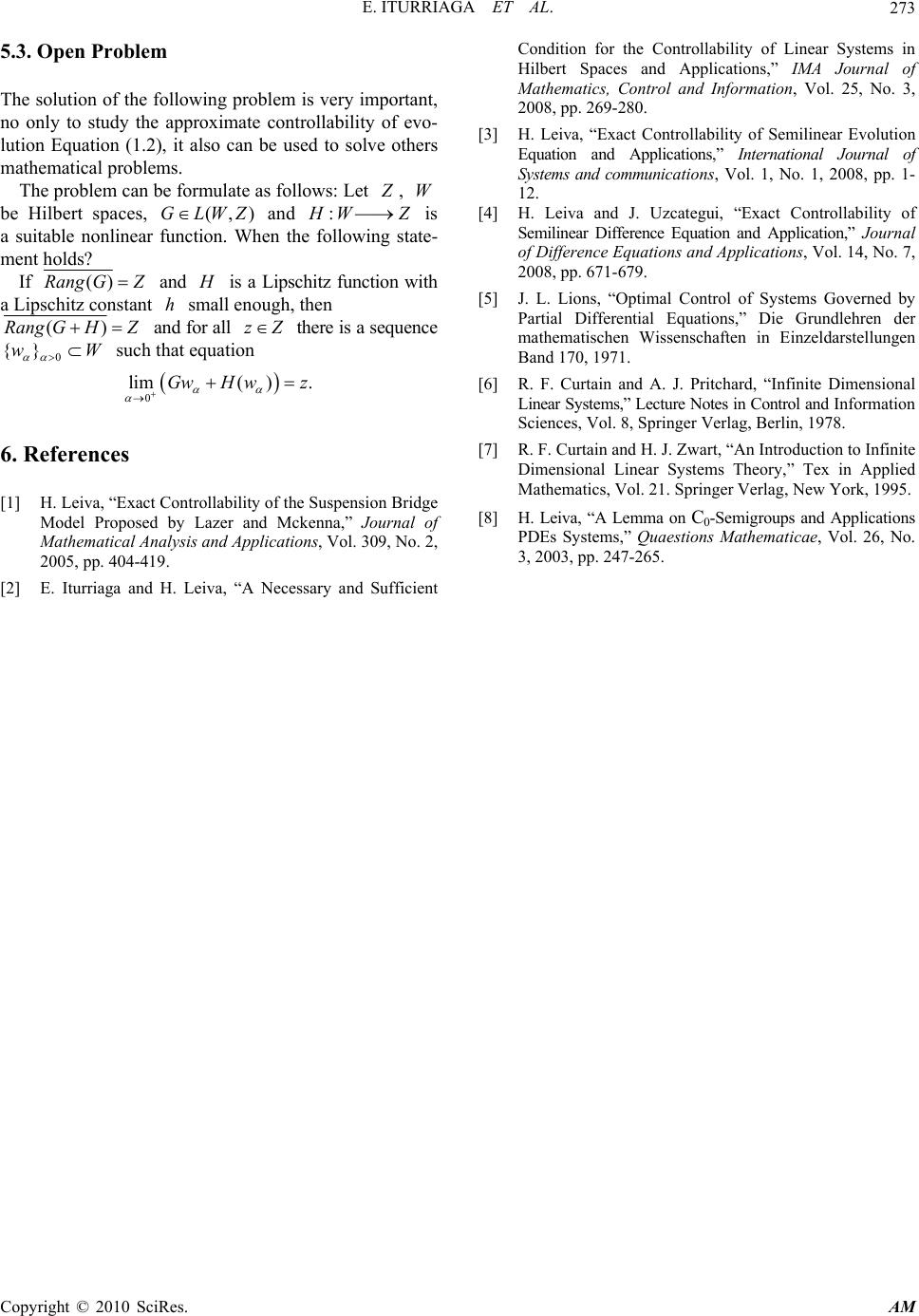 E. ITURRIAGA ET AL. Copyright © 2010 SciRes. AM 273 5.3. Open Problem The solution of the following problem is very important, no only to study the approximate controllability of evo- lution Equation (1.2), it also can be used to solve others mathematical problems. The problem can be formulate as follows: Let Z , W be Hilbert spaces, ()GLWZ and H WZ is a suitable nonlinear function. When the following state- ment holds? If ()Rang GZ and H is a Lipschitz function with a Lipschitz constant h small enough, then ()Rang GHZ and for all zZ there is a sequence 0 {}wW such that equation 0 lim()GwHwz 6. References [1] H. Leiva, “Exact Controllability of the Suspension Bridge Model Proposed by Lazer and Mckenna,” Journal of Mathematical Analysis and Applications, Vol. 309, No. 2, 2005, pp. 404-419. [2] E. Iturriaga and H. Leiva, “A Necessary and Sufficient Condition for the Controllability of Linear Systems in Hilbert Spaces and Applications,” IMA Journal of Mathematics, Control and Information, Vol. 25, No. 3, 2008, pp. 269-280. [3] H. Leiva, “Exact Controllability of Semilinear Evolution Equation and Applications,” International Journal of Systems and communications, Vol. 1, No. 1, 2008, pp. 1- 12. [4] H. Leiva and J. Uzcategui, “Exact Controllability of Semilinear Difference Equation and Application,” Journal of Difference Equations and Applications, Vol. 14, No. 7, 2008, pp. 671-679. [5] J. L. Lions, “Optimal Control of Systems Governed by Partial Differential Equations,” Die Grundlehren der mathematischen Wissenschaften in Einzeldarstellungen Band 170, 1971. [6] R. F. Curtain and A. J. Pritchard, “Infinite Dimensional Linear Systems,” Le cture Notes in Control and I n for m at io n Sciences, Vol. 8, Springer Verlag, Berlin, 1978. [7] R. F. Curtain and H. J. Zwart, “An Introduction to Infinite Dimensional Linear Systems Theory,” Tex in Applied Mathematics, Vol. 21. Springer Verlag, New York, 1995. [8] H. Leiva, “A Lemma on C0-Semigroups and Applications PDEs Systems,” Quaestions Mathematicae, Vol. 26, No. 3, 2003, pp. 247-265. |

